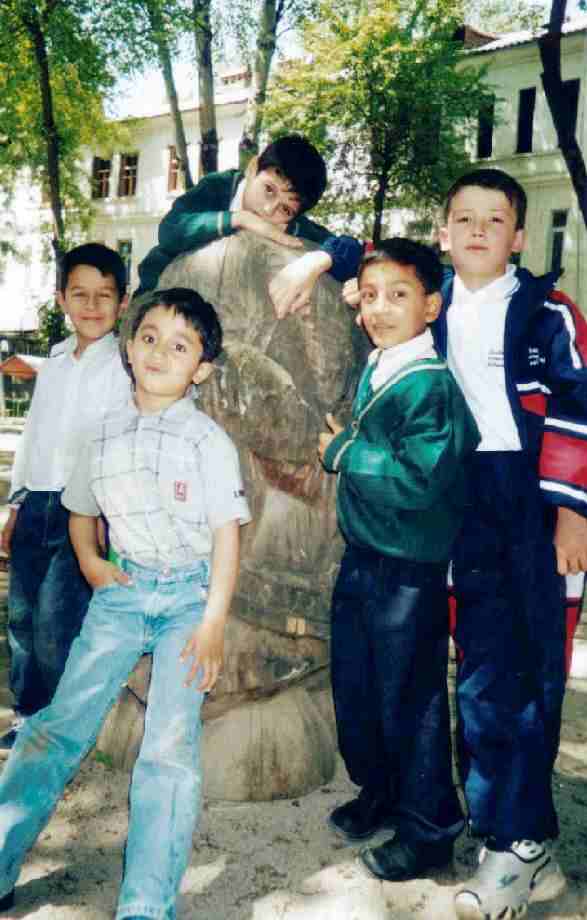
Figure 1.--Boys in Tajikistan in 2003 wears clothing that is indistinguishabe from contemprary European styles. Some of the boys are wearing theor school uniforms.


Figure 1.--Boys in Tajikistan in 2003 wears clothing that is indistinguishabe from contemprary European styles. Some of the boys are wearing theor school uniforms. |
We have begun to build a basic historical chronology for Tajikistan. We have collected some basic information, but so far have very limited inforation about Tajik boys' clothing at over time.
Tajiks maintain that they are the oldest people of Central Asia. What is now Takikistan was part of the Persian Empire. A major art find is known as the Oxus River Treasure. The current Tajik state has borders established by Soviet authorities in the 1920s. The modern borders have no real foundation based on the history of the Tajik people. Uzbeks and Tajiks shared much common history and culture, more so than with Kyrgyz and Turkmen. Persians are believed to have founded the first cities in Central. Tajiks played a role in fabeled Silk Road connection between Europe and China. The Golden Era of Tajik history was the Samanids (9th and 10th centuries AD). Turkic culture much later became firmly established (14th century). The result was a complex interplay of cultural currents which resulted in Turkic-Persian sedentary civilization with a inter-mixture of peoples, languages, traditions, and symbols. [Torbakov]
Tsarist Russia conquered Tajikistan and the rest of Central Asia in the second half of the 19th century. It was the final step in the Russian move east which began in the 15th century after Ivan the Terrible freed Moscovy from tribute to the Goldren Horde and then conquered the Tartar Kingdoms. ThecRussian conquest of central Asia was incredibly brutal. The great Russian artist Vereshchagin depicted a scene of a huge mound of human heads which Russian soldiers severed from defeated Central Asians. The Russians used Central Asia as a source of raw material. The Russians administered southern Tajikistan through the amir of Bukhara. The amir looked on the eastern
area of his principality as a colony to exploit. Northern Tajikistan was ruled directly by the Russian governor-general in Tashkent and became an integral part of the Russian Empire. The growth of Russia's textile industry created a great demand for cotton. Thus cotton cultivation was expanded thrroughout Central Asia and the ecomomies shifted to exporting raw materials. Central Asia had always been seen by the Russians as a source of raw material, but the the level of trade expanded greatly because of the demand in Russia for cotton. This created a vibrant export economy which brought railroads and some aspects of modern life. Tajikistan's economy was no longer isolated, and largely self-sufficient, but was now part of the larger world economy. [Asimov] Another feature of Tsarist rule was Russification. The assessment of Russification is a difficult historical and sociolgical problem. Part of Russification was Russian imperialism and oppression of the Tajik people. Another part was the introduction of modern Western techhnology and outlook. As a Tajik scholar explains, "The problem of russification should be analyzed from this point of view: to what extent did russification destroy our traditional culture and to what extent did it lead toa blend of eastern and western culture. We have to separate two things: first, the compulsory russification, which certainly was a violation of the very basis of our life; second, the natural and beneficent process of opening Russian and Western culture to the population of Central Asia." [Asimov]
The Soviets brought Takistan into the modern world, but the record is mixed. They established universities and a modern school system which esseniatally ended illiteracy. The Soviets established industries and hydropower stations. They also built a medical system. Soviet archaeologists discovered important ancient sites. [Asimov] All this came at the price of Stalinist oppression and economic mismanagement. In addition, Soviet industry and agriculture have left Tajikistan with serious ecoligical problems. Western clothes were first introduced to Tajikistan during the Soviet era. Even well into the 20th century, traditional clothing was still commonly worn in Tajikistan. We have one 20th century artistic depiction of traditional clothing. Children wore Soviet school uniforms. After World War II, with the raid industriatization of the country and the influx ofincreasing numbers of Russians, modern European styles became increasing common.
Today in Tajikistan, boys wear modern styles that are indishtinguishable from contemporary European styles. Some of the boys here are wearing their school uniform (green sweaters and white shirts) in a photograph taken in the afternoon after school (figure 1). Note that the school uniform is very European, nothing like the military-styled school uniform worn in Soviet days.
Asimov, M.S. Asimov. "Rewriting Tajik History" (Tajik Academy of Sciences: Dushanbe, undated but site accessed September 13, 2003).
Torbakov, Igor."Tajik-Uzbek Relations: Divergent National Historiographies Threaten To Aggravate Tensions," (Eurasia.org, June 12, 2001).
Related Chronolgy Pages in the Boys' Historical Web Site
[The 1880s]
[The 1890s]
[The 1900s]
[The 1910s]
[The 1920s]
[The 1930s]
[The 1940s]
[The 1930s]
[The 1940s]
[The 1950s]
[The 1960s]
[The 1970s]
[The 1980s]
Related Style Pages in the Boys' Historical Web Site
[Long pants suits]
[Knicker suits]
[Short pants suits]
[Socks]
[Eton suits]
[Jacket and trousers]
[Blazer]
[School sandals]
[School smocks]
[Sailor suits]
[Pinafores]
[Long stockings]
Navigate the Boys' Historical Clothing Web Page
[Return to the Main Tajik country page]
[Introduction]
[Activities]
[Biographies]
[Chronology]
[Clothing styles]
[Countries]
[Bibliographies]
[Contributions]
[FAQs]
[Glossaries]
[Satellite sites]
[Tools]
[Boys' Clothing Home]
